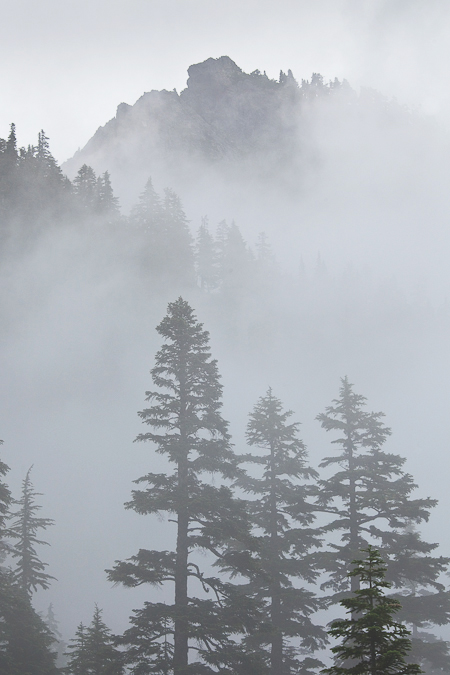 Denny Creek cascades over a series of waterfalls near the trail
Denny Creek cascades over a series of waterfalls near the trail
A hike starting between the eastbound and westbound lanes of Interstate 90 might seem less than promising. But we didn’t give up, even after the trailhead parking lot was full by 9:30 a.m. on a Saturday and the freeway noise was constant.
The trail to Melakwa Lake is like that; since it is so close to Seattle, being on the near side of Snoqualmie Pass, it gets heavy use. The trail leads directly under the tall, elevated viaduct that is the westbound route of I-90. I find the viaduct strangely beautiful; it was built so that avalanches could pass directly underneath, without affecting traffic. The contrast of the massive and elegantly simple concrete structure with the wild and visually complex forest below is astounding.
 The Snoqualmie Pass Viaduct lets avalanches slip underneath
The Snoqualmie Pass Viaduct lets avalanches slip underneath
Farther up the trail, families gather on the smooth stone along one stretch of Denny Creek for cooling off on hot summer days. Still, farther, there is dramatic Keekwulee Falls. After that, only the young and/or hardy make the hike to Melakwa Lake, which has a 2,300′ elevation gain in just a few miles.
We camped near the smaller lake, and enjoyed a quiet night with a bit of rain and low clouds that swirled and danced among the rugged peaks and pointed firs. I didn’t realize it until later, but “Melakwa” is a native word for “mosquito,” and the lake lived up to its name (what’s a wilderness experience without a struggle?). Worse than mosquitoes were the black flies, tiny creatures that love to fly behind your glasses and bite you right at the hatline. I came back with four nasty bites that still itch and are swollen as I write this, a week and a half later. There were also biting flies of normal size that pestered us on the way up the trail, but their bite isn’t as bad as their buzz.
I’ll let the photographs tell most of the story, but there was one additional event that we found interesting. When I looked into Melakwa Lake on Sunday, the sun’s reflection appeared coppery in color. I thought maybe it was something about the lake’s blue color that changed the reflection; but on the hike down, the late afternoon sun turned tree trunks a bright burnt orange color. Then, on the drive home, the setting sun was a ball of dark (not bright) orange in the sky–something I had never observed in Seattle before, though it was common in central New York where I once lived. We heard later that the unusual color of the sun was due to smoke from forest fires burning in British Columbia.
For more information about the Melakwa Lake hike, including trip reports by numerous hikers, go to: http://www.wta.org/go-hiking/hikes/melakwa-lake
 American Pikas, relatives of rabbits, live among talus slope rocks in the basin containing Melakwa Lake; they make their living by gathering wildflowers and sedges and storing the dried “hay” for the long winter. They live under the snow and do not hibernate.
American Pikas, relatives of rabbits, live among talus slope rocks in the basin containing Melakwa Lake; they make their living by gathering wildflowers and sedges and storing the dried “hay” for the long winter. They live under the snow and do not hibernate.
 GROSS ALERT: Pika scats, which Pikas eat, thus ingesting nutrients they didn’t absorb the first time around
GROSS ALERT: Pika scats, which Pikas eat, thus ingesting nutrients they didn’t absorb the first time around
 Pink Mountain Heather at its peak of bloom
Pink Mountain Heather at its peak of bloom
 Meet “Misty Melakwa,” our snowlady for the trip
Meet “Misty Melakwa,” our snowlady for the trip
 The smooth rocks in one stretch of Denny Creek are great for sliding
The smooth rocks in one stretch of Denny Creek are great for sliding
 A Dark-eyed Junco (aka “Snowbird”) sang in the mist above our tent
A Dark-eyed Junco (aka “Snowbird”) sang in the mist above our tent
 There were about six tents in the basin the night we visited
There were about six tents in the basin the night we visited
 An American Dipper peering into the stream near our tent
An American Dipper peering into the stream near our tent
 Evening and early morning were misty, with low clouds shrouding the mountains
Evening and early morning were misty, with low clouds shrouding the mountains
 Colorful stones in the crystal clear waters of Denny Creek
Colorful stones in the crystal clear waters of Denny Creek
 Green False Hellebore, a favorite of mountain photographers, is deadly; so don’t eat it!
Green False Hellebore, a favorite of mountain photographers, is deadly; so don’t eat it!
 The blue glow of a misty deep twilight
The blue glow of a misty deep twilight
 I believe this rock, tortured and twisted with chunks and flows, is termed a skarn
I believe this rock, tortured and twisted with chunks and flows, is termed a skarn
 Pacific Silver Fir shredded and gnawed by a black bear
Pacific Silver Fir shredded and gnawed by a black bear
 Keekwulee Falls along Denny Creek
Keekwulee Falls along Denny Creek
 Morning fog above Melakwa Lake
Morning fog above Melakwa Lake
 Waves give a painterly look to Melakwa Lake
Waves give a painterly look to Melakwa Lake
 A coppery sun, tinted by forest fires, reflects off the waves of Melakwa Lake
A coppery sun, tinted by forest fires, reflects off the waves of Melakwa Lake



















